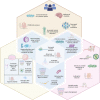From wings to whiskers to stem cells: why every model matters in fragile X syndrome research
- PMID: 38872088
- PMCID: PMC11177515
- DOI: 10.1186/s11689-024-09545-w
From wings to whiskers to stem cells: why every model matters in fragile X syndrome research
Abstract
Fragile X syndrome (FXS) is caused by epigenetic silencing of the X-linked fragile X messenger ribonucleoprotein 1 (FMR1) gene located on chromosome Xq27.3, which leads to the loss of its protein product, fragile X messenger ribonucleoprotein (FMRP). It is the most prevalent inherited form of intellectual disability and the highest single genetic cause of autism. Since the discovery of the genetic basis of FXS, extensive studies using animal models and human pluripotent stem cells have unveiled the functions of FMRP and mechanisms underlying FXS. However, clinical trials have not yielded successful treatment. Here we review what we have learned from commonly used models for FXS, potential limitations of these models, and recommendations for future steps.
Keywords: Drosophila; FMR1; FMRP; Fragile X syndrome; Human; Mouse; Neuron; Organoid; Stem cells; iPSCs.
© 2024. The Author(s).
Conflict of interest statement
The authors declare no competing interests.
Figures

Similar articles
-
Epigenetic characterization of the FMR1 gene and aberrant neurodevelopment in human induced pluripotent stem cell models of fragile X syndrome.PLoS One. 2011;6(10):e26203. doi: 10.1371/journal.pone.0026203. Epub 2011 Oct 12. PLoS One. 2011. PMID: 22022567 Free PMC article.
-
Human pluripotent stem cell models of Fragile X syndrome.Mol Cell Neurosci. 2016 Jun;73:43-51. doi: 10.1016/j.mcn.2015.11.011. Epub 2015 Nov 27. Mol Cell Neurosci. 2016. PMID: 26640241 Free PMC article. Review.
-
microRNAs and Fragile X Syndrome.Adv Exp Med Biol. 2015;888:107-21. doi: 10.1007/978-3-319-22671-2_7. Adv Exp Med Biol. 2015. PMID: 26663181
-
The feasibility and utility of hair follicle sampling to measure FMRP and FMR1 mRNA in children with or without fragile X syndrome: a pilot study.J Neurodev Disord. 2022 Dec 9;14(1):57. doi: 10.1186/s11689-022-09465-7. J Neurodev Disord. 2022. PMID: 36494616 Free PMC article.
-
Epigenetic modifications in human fragile X pluripotent stem cells; Implications in fragile X syndrome modeling.Brain Res. 2017 Feb 1;1656:55-62. doi: 10.1016/j.brainres.2015.10.004. Epub 2015 Oct 20. Brain Res. 2017. PMID: 26475977 Review.
Cited by
-
Scheduled feeding improves behavioral outcomes and reduces inflammation in a mouse model of Fragile X syndrome.bioRxiv [Preprint]. 2025 Jul 21:2024.09.16.613343. doi: 10.1101/2024.09.16.613343. bioRxiv. 2025. PMID: 39345407 Free PMC article. Preprint.
-
Affordable mRNA Novel Proteins, Recombinant Protein Conversions, and Biosimilars-Advice to Developers and Regulatory Agencies.Biomedicines. 2025 Jan 3;13(1):97. doi: 10.3390/biomedicines13010097. Biomedicines. 2025. PMID: 39857681 Free PMC article. Review.
References
Publication types
MeSH terms
Substances
Grants and funding
- P50HD105353/National Institute of Child Health and Human Development
- R01 MH136152/MH/NIMH NIH HHS/United States
- T32 GM141013/GM/NIGMS NIH HHS/United States
- R36MH136790/DK/NIDDK NIH HHS/United States
- R01MH116582/GF/NIH HHS/United States
- Eagles Autism Foundation/Eagles Autism Foundation
- R01 MH118827/MH/NIMH NIH HHS/United States
- R01 MH116582/MH/NIMH NIH HHS/United States
- R01MH118827 diversity supplement/GF/NIH HHS/United States
- R01MH118827/GF/NIH HHS/United States
- graduate support/SciMed
- FRAXA Research Foundation/FRAXA Research Foundation
- P50 HD105353/HD/NICHD NIH HHS/United States
- R36 MH136790/MH/NIMH NIH HHS/United States
LinkOut - more resources
Full Text Sources
Medical
Molecular Biology Databases

